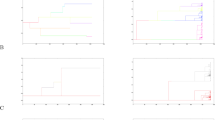Abstract
We shall extend Kingman's coalescent to the geographically structured population model with migration among colonies. It is described by a continuous-time Markov chain, which is proved to be a dual process of the diffusion process of stepping-stone model. We shall derive a system of equations for the spatial distribution of a common ancestor of sampled genes from colonies and the mean time to getting to one common ancestor. These equations are solved in three particular models; a two-population model, the island model and the one-dimensional stepping-stone model with symmetric nearest-neighbour migration.
Similar content being viewed by others
References
Cox, J. T., Griffeath, D.: Diffusive clustering in the two dimensional voter model. Ann. Probab. 14, 347–370 (1986)
Darden, T., Kaplan, N. L., Hudson, R. R.: A numerical method for calculating moments of coalescent times in finite populations with selection. J. Math. Biol. 27, 355–368 (1989)
Donnelly, P.: The transient behaviour of the Moran model in population genetics. Math. Proc. Camb. Phil. Soc. 95, 349–358 (1984)
Donnelly, P.: Dual processes and an invariance result for exchangeable models in population genetics. J. Math. Biol. 23, 103–118 (1985)
Donnelly, P., Tavare, S.: The population genealogy of the infinitely-many neutral alleles model. J. Math. Biol. 25, 381–391 (1987)
Ethier, S. N., Griffiths, R. C.: The infinitely-many-sites model as a measure-valued diffusion. Ann. Probab. 15, 515–545 (1987)
Gladstien, K.: The characteristic values and vectors for a class of stochastic matrices arising in genetics. SIAM. J. Appl. Math. 34, 630–642 (1978)
Griffeath, D.: Additive and cancellative interacting particle system. (Lect. Notes Math., vol. 724) Berlin Heidelberg New York: Springer 1979
Griffiths, R. C.: Lines of descent in the diffusion approximation of neutral Wright-Fisher models. Theor. Popul. Biol. 17, 37–55 (1980)
Griffiths, R. C.: The number of alleles and segregating sites in a sample from the infinite alleles model. Adv. Appl. Probab. 14, 225–239 (1982)
Griffiths, R. C.: Counting genealogical trees. J. Math. Biol. 25, 423–431 (1987)
Hudson, R. R., Kaplan, N. L.: The coalescent process in models with selection and recombination. Genetics 120, 831–840 (1988)
Kaplan, N. L., Darden, T., Hudson, R. R.: The coalescent process in models with selection. Genetics 120, 819–829 (1988)
Karlin, S., Taylor, H. M.: A second course in stochastic processes. New York: Academic Press 1980
Kingman, J. F. C.: On the genealogy of large populations. J. Appl. Probab. 19A, 27–43 (1982)
Kingman, J. F. C.: The coalescent. Stochastic Processes Appl. 13, 235–248 (1982)
Liggett, T. M.: Interacting particle system. Berlin Heidelberg New York: Springer 1985
Nagylaki, T.: The strong-migration limit in geographically structured populations. J. Math. Biol. 9, 101–114 (1980)
Nagylaki, T.: The robustness of neutral models of geographical variation. Theor. Popul. Biol. 24, 268–294 (1983)
Nagylaki, T.: Neutral models of geographical variation stochastic spatial process. (Lest. Notes Math., vol. 1212, pp. 216–237) Berlin Heidelberg New York: Springer 1986
Notohara, M., Shiga, T.: Convergence to genetically uniform state in stepping stone models of population genetics. J. Math. Biol. 10, 281–294 (1980)
Padmadisastra, S.: The genetic divergence of three populations. Theor. Popul. Biol. 32, 347–365 (1987)
Sawyer, S.: Results for the stepping stone model for migration in population genetics. Ann. Probab. 4, 699–728 (1976)
Shiga, T.: An interacting system in population genetics I, and II. J. Math. Kyoto Univ. 20, 212–242 and 723–733 (1980)
Shiga, T.: Continuous time multi-allelic stepping stone models in population genetics. J. Math. Kyoto Univ. 22, 1–40 (1982)
Takahata, N.: The coalescent in two partially isolated diffusion populations. Genet. Res., Camb. 52, 213–222 (1988)
Takahata, N.: Gene genealogy in three related populations: consistency probability between gene and population trees. Genetics 122, 957–966 (1989)
Tavaré, S.: Line of descent and genealogical process and their application in population genetics model. Theor. Popul. Biol. 26, 119–164 (1984)
Tavaré, S.: The birth process with immigration and the genealogical structure of large populations. J. Math. Biol. 25, 161–168 (1987)
Watterson, G. A.: Lines of descent and the coalescent. Theor. Popul. Biol. 26, 77–92 (1984)
Watterson, G. A.: The genetic divergence of two populations. Theor. Popul. Biol. 27, 298–317 (1985)
Author information
Authors and Affiliations
Rights and permissions
About this article
Cite this article
Notohara, M. The coalescent and the genealogical process in geographically structured population. J. Math. Biol. 29, 59–75 (1990). https://doi.org/10.1007/BF00173909
Received:
Revised:
Issue Date:
DOI: https://doi.org/10.1007/BF00173909




